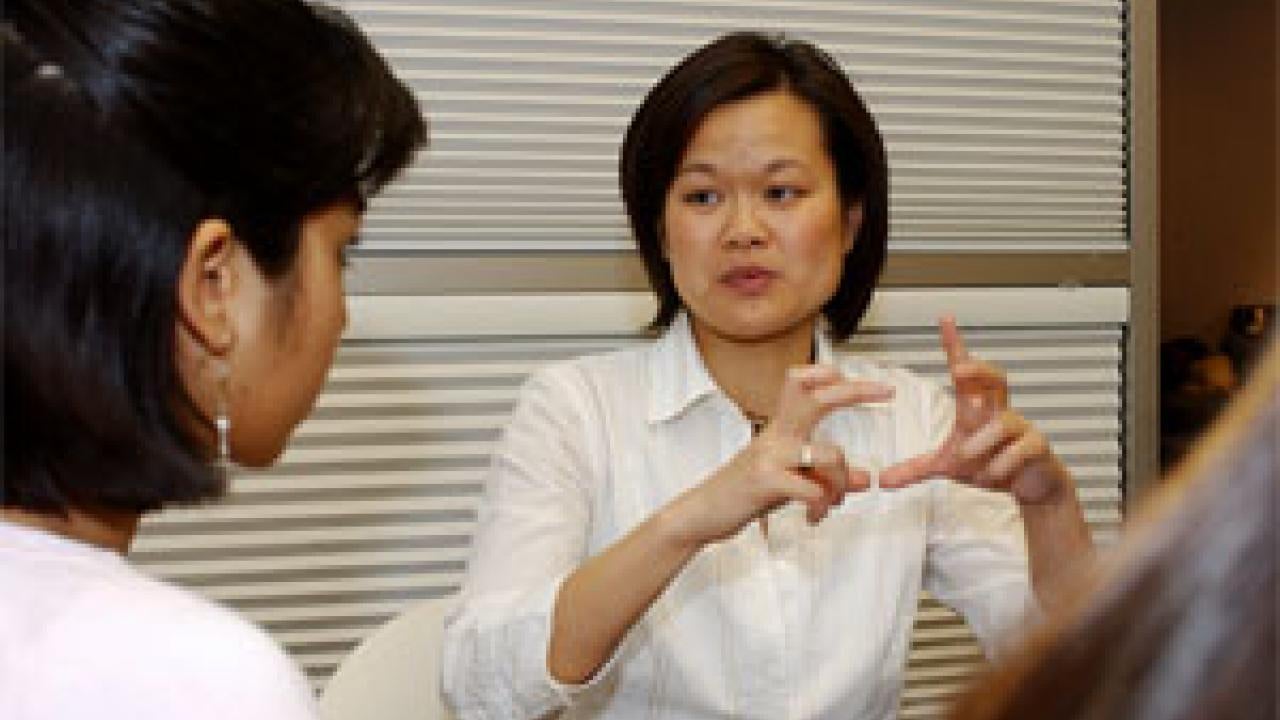The campus is working to close a gap between what foreign languages it offers and those increasingly in demand by students in a melting-pot California.
In recent years, UC Davis has rolled out courses in Farsi, Korean, Tagalog, Mandarin, Japanese, Russian, Italian, Vietnamese and Cantonese. It is all made possible by an arrangement with the Sacramento City College's Davis branch.
Anita Poon, a student affairs coordinator for Asian American Studies, has advised many students seeking access to such languages.
"There is a great demand for these classes," Poon said, "and the university needs to offer more of them."
A few years ago at Poon's urging, the Student Affairs and Research Information group surveyed undergraduate students about what languages they take if UC Davis offered those courses.
The study, released in 2003, found that the languages most often cited were those from the Asian Rim. It noted that 32 percent of respondents said that they would like to enroll in a language not currently offered at UC Davis. Of the top 10 requested languages, seven — Korean, Tagalog, Punjabi, Hindi, Arabic, Vietnamese and Farsi — are spoken by five of the 10 countries from which California receives the most immigrants. The 2000 census showed that 26.2 percent of California's population was foreign born.
The Davis study underscored that most people (39 percent) were interested in these types of languages for personal or cultural reasons. Others (23 percent) said that the language would be of a utilitarian or practical value to them.
Korean was the most frequently requested new language even though the Korean undergraduate population of UC Davis was only 2.7 percent of undergraduate student population at that time.
Cultural and practical
Foreign languages are sometimes viewed as a ticket to the future, or a trip to one's ethnic past.
Loan Ly, a recent UC Davis graduate, is among those advocating the university to offer more languages out of the Spanish-German-French mainstream. Ly took a Vietnamese language class two years ago, she says, for both cultural and practical reasons.
"As the eldest child, I have seen how language can be lost so quickly," Ly said. "My three younger brothers were born in the U.S., and they can barely speak Vietnamese. I also want to read Vietnamese documents to my mother who never received an education."
Ly is among hundreds of UC Davis students annually taking advantage of some of the world's more exotic languages through a joint effort by the university and Sacramento City College's Davis branch. This year, Mandarin and Cantonese were offered and it is hoped that next year Arabic and Punjabi will be available. Mandarin is offered on campus, but now SCC also offers it to help meet demand — just as they do with Spanish.
UC Davis students can enroll in and attend the courses taught by SCC instructors and receive credit for them. The benefit of this arrangement is that SCC has greater flexibility than a large university to hire adjunct instructors for specific languages. The classes are usually held in the evening in Olson Hall.
Today, Ly continues her study of Vietnamese on her own and says that while her skills may be limited, she hopes to one day use it in the classroom.
"I want to be a high school teacher, and learning Vietnamese will allow me to better communicate with parents," she said.
Trend nationwide
Like Ly, students nationwide are flocking to foreign languages. A 2003 survey by the Modern Language Association found that more college students than ever were studying foreign languages, and that colleges and universities, like UC Davis, offered a greater variety of language courses than they did five years ago.
Spanish continued to be the most widely taught language in academe, accounting for 53 percent of total foreign-language enrollments in 2002. The next most popular languages after Spanish were French and German. The percentage of students taking a language — 8.7 percent — was the highest since 1972.
Fred Wood, vice provost for undergraduate studies at UC Davis, said, "Learning a new language gives students a real-world vision of the kinds of things they can do with languages, and the importance of languages in our multi-cultural world. We are building up our capacity to meet the demands of students for these less commonly taught languages."
Wood noted that the "internationalization of the global economy" is among the chief reasons students show interest in the less traditional languages.
"We live in a different world than we did 30 or 40 years ago," he said, "and I think this demand for a broader array of languages demonstrates this yearning to more fully embrace the world beyond our borders."
Key collaboration
John Ruden, dean of students at the Davis branch of Sacramento City College, says that his institution and UC Davis both collaborate on the development of new language courses. It may take a year from when the idea originates for a new course to when the curriculum is designed and then offered in the classroom. And, it takes the UC Office of the President another year or two to approve the courses for UC credit, he added.
Ruden estimates that UC Davis students account for about one-third to one-half of all the students enrolled in the SCC Davis language courses. "It varies, and in Vietnamese it may be around 50 percent."
The language courses usually begin at the class maximum of 35 students and with waiting lists, he said. Attrition reduces that number and allows entry by those waiting.
"The programs are growing by leaps and bounds," Ruden said.
Media Resources
Clifton B. Parker, Dateline, (530) 752-1932, cparker@ucdavis.edu
